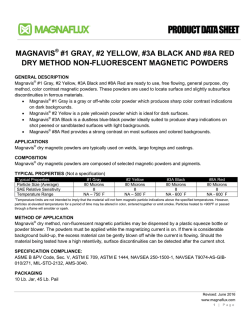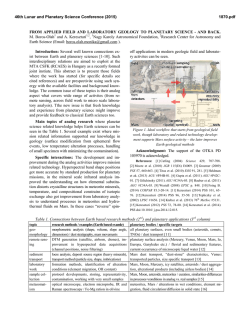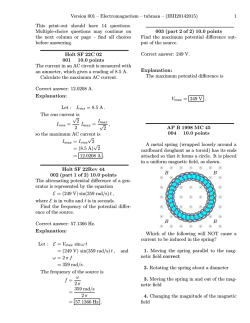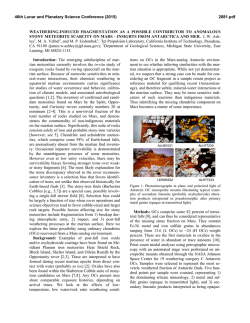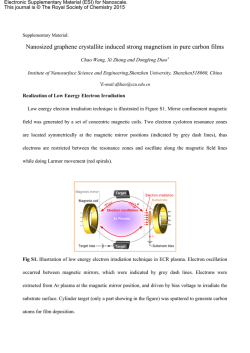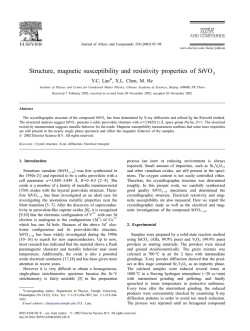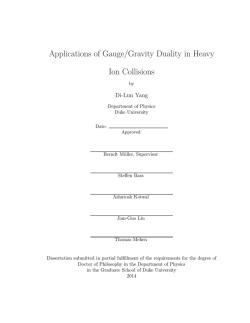
Depth Estimates and Its Implications from Second Moving Average
46th Lunar and Planetary Science Conference (2015) 1977.pdf Depth Estimates and Its Implications from Second Moving Average Residual Magnetic Anomalies on Mars. K. S. Essa1 and G. Kletetschka2,3,4, 1Geophysics Department, Faculty of Science, Cairo University, 12613 Giza, Egypt. E-mail: [email protected], 2Institute of Geology, Academy of Science of the Czech Republic, v.v.i., Prague, Czech Republic, 3Faculty of Science, Charles University in Prague, Czech Republic, 4LBNL, Nuclear Science, Berkeley, CA, USA. E-mail: [email protected]. Introduction: Mars Global Surveyor mission obtained detailed magnetic data set of Mars from 400 km satellite altitude, launched in 1996 . Many contrasting magnetic anomalies have been identified [1, 2] but consensus about the source depth remains unclear. The variations of magnetic anomalies are greater in magnitude than the anomalies on Earth [3, 4]. The part of the southern hemisphere of the Martian crust is strongly magnetized, as indicated by large intensities of respective magnetic anomalies, while the northern hemisphere has lower magnetic signatures suggesting either lower magnetizations or deeper location of magnetic sources in respect to satellite altitude 400 km. Variation in magnetization of the source can be due to several reasons [5, 6]. The formation of the strong crustal magnetic sources on Mars can be divided into several categories: the first depends on hydrothermal alteration of preexisting crustal materials to produce efficient remanent magnetization carriers over large depth ranges [7]. The second category employs water rich fluids that precipitate iron rich carbonates for which we have evidence in Martian meteorites [8]. The third category considers highly magnetic intrusions, which are rich in iron [9]. Possible remanence carriers on Mars include magnetite, hematite, and pyrrhotite [10]. The aim of the present study is using Mars total magnetic data (Fig. 1) to estimate the depth of the buried sources using a second moving average (SMA) method [11]. Twelve profiles were chosen across major magnetic areas. Each profile was subjected to the SMA separation technique. SMA residual anomalies were obtained from magnetic data using filters of successive spacing. The depth estimate is monitored by a standard deviation of the SMA determined depths for three shape factor values (q) that include dike, cylinder, and sphere. The depth estimates for sources of the specific anomalies, along with related estimate of its standard deviation, are considered to be a new criterion for determining the depth and shape of the buried magnetic sources on Mars. Fig. 1. A total intensity global magnetic map of Mars obtained from 400 km altitude with profles across major magnetic anomalies [3]. The method: The inversion technique depends on the magnetic anomaly T [nT] produced by most common three shapes (q= 2.5 for sphere, 2 for cylinder along the profile, 1 for vertical dike) of geologic magnetically contrasting structures and can be represented by the following equation [12] T ( xi , z, , q) KW ( xi , z, , q) , i 1,2,3,...N (1) The numerical SMA residual magnetic anomaly R2(xi, z, θ, q, s) is given [nT] by equation: 6T (xi ) 4T (xi s) 4T (xi s) T (xi 2s) T (xi 2s) (2) . 4 where s = 1, 2, 3, . . . spacing units is the window length in kilometers. Using equation (2), and substituting for the following values at xi = 0, xi = s, and xi = -s, respectively, leads to the following nonlinear equation in z [11] R2 (xi ) 1 2r 2q az2r 4bs2 5 az2r bs2 az2r 4bs2 az2r 9bs2 az2r bs2 3z 2r 2q z F q q q q q 4 a s2 z 2 4a 4s2 z 2 4a s2 z 2 a 4s2 z 2 4a 9s2 z 2 (3) The equation (3) can be solved using the iterative fixed-point method [13]. The iteration form of equation (3) is given as z f f (z j ) (4) where zj is the initial depth and zf is the revised depth. zf is be used as the zj for next iteration. 46th Lunar and Planetary Science Conference (2015) Discussion of the results: We tested the application and stability of this method on twelve magnetic anomalies, P1, P2, P3, … and P12, each of them containing 4 crossing profiles (a, b, c, d in Fig. 1). The location of these particular profiles was chosen in places where the data set contains significant isolated magnetic anomaly, which appear on this total intensity magnetic map (Fig. 1). Each profile was subject to inversion techniques yielding the depth (z) and the shape of the buried structure (q). The inversion results of twelve sets of profiles (P1, P2, P3, … and P12) suggest that the sources of Martian crustal magnetic anomalies consist primarily of dikes rich in magnetic minerals suggesting that the sources may have undergone stratification/lamination during the crustal differentiation of Mars. This supports convection mechanisms for releasing the heat from the early forming planet [14]. Depth estimates of the magnetic sources (Fig 2.) indicates that the half of the southern hemisphere starting from southern part of Tharis volcanic province have much shallower sources (120 – 260 km) than the opposing half containing Hellas impact structure. The deepest sources are near hight sourthern latitudes north-east from the Prometheus impact basin. Fig. 2. The inversion depth map of the twelve magnetic anomalies. Summary remarks: The relatively simple technique for practicalsepth estimates has been illustrated on twelve magnetic anomaly profiles with various geological settings on Mars. The estimated inverse parameters based on the real data contrast the view that the Martian anomalies cannot be deeper than 50 km [15-17]. Our analysis as well as other even more simple techniques [11] suggest sources exceeding 100 km depth. The results produced in this analysis indicate that magnetic anomalies on Mars are generated by dike shape bodies at depth between 100 and 500 km whose depth consistently increase towards the region north east of the Prometheus impact basin and is suddenly shallowed under the Tharsis volcanic province. 1977.pdf References: [1] Acuna M. H. et al. (2001) J. Geophys. Res.Planets, 106(E10), 23403-23417. [2] Connerney J. E. P. et al. (1999) Science, 284(5415), 794-798. [3] Connerney J. E. P. et al. (2001) Geophys. Res. Lett., 28(21), 4015-4018. [4] Purucker M. et al. (2000) Geophys. Res. Lett., 27(16), 2449-2452. [5] Kletetschka G. et al. (2000) Meteoritics & Planetary Science, 35(5), 895-899. [6] Kletetschka G. et al. (2005) Physics of the Earth and Planetary Interiors, 148(2-4), 149-156. [7] Quesnel Y. et al. (2009) Earth Planet. Sci. Lett., 277(1-2), 184-193. [8] Scott E. R. D. and Fuller M. (2004) Earth Planet. Sci. Lett., 220(1-2), 83-90. [9] Arkani-Hamed J. (2005) J. Geophys. Res.-Planets, 110(E12). [10] Kletetschka G. et al. (2004) Meteoritics & Planetary Science, 39(11), 1839-1848. [11] Abdelrahman, E. M. et al. (2004) Journal of King Abdulaziz University: Earth Sci., 15, 181-196. [12] Abdelrahman E. S. M. and Essa K. S. (2005) Geophysics, 70(3), L23-L30. [13] Mustoe L. R. and Barry M. D. J. (1998), Mathematics in Engineering and Science, Wiley, New York. [14] Kletetschka G. et al. (2009) Meteoritics & Planetary Science, 44(1), 131-140. [15] Dunlop D. J. and Arkani-Hamed J. (2005) J. Geophys. Res.-Planets, 110(E12), 1-11. [16] Harrison K. P. and Grimm R. E. (2002) J. Geophys. Res.-Planets, 107(E5). [17] Langlais B. and Thebault E. (2011) Icarus, 212(2), 568-578.
© Copyright 2026

